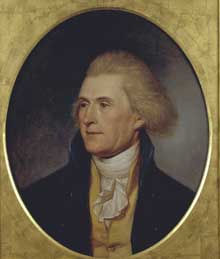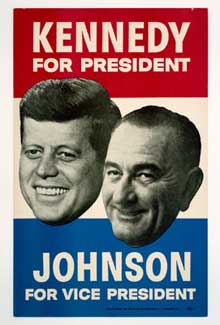New Exhibition: Presidents in Waiting

The vice presidency—a heartbeat away from what has been called the most powerful job in the world—has often been a subject of ridicule and dismissal rather than serious analysis. “Presidents in Waiting” takes a different viewpoint, emphasizing the importance of that office. It focuses on the fourteen vice presidents—almost one-third of our forty-three chief executives—who succeeded to the presidency, either upon the death of a sitting president, election in their own right, or (in one case), the resignation of a president.
“Presidents in Waiting” also offers interviews, conducted especially for this exhibition, in which the former vice presidents discuss their role and their relationship with the president. The exhibition is on view at National Portrait Gallery until January 3, 2010.

Peale, 1791 / Oil on canvas /
Independence National
Historical Park Collection,
Philadelphia, Pennsylvania
The framers of the Constitution believed that the vice presidency was significant enough to be occupied by a national figure—the runner-up in the presidential election. The Constitution, written before political parties emerged, specified that the candidate with the second-highest number of votes in the Electoral College would become vice president.
When political parties evolved during the 1790s, a change in procedure eventually became necessary because the candidate who came in second would belong to a different political party from that of the president-elect, as happened when Thomas Jefferson (left) became John Adams’s vice president in 1797. More complications during the election of 1800 resulted in the Twelfth Amendment being added to the Constitution in 1804, which had the electors voting separately for president and vice president.
A different public and private perception of the vice presidency quickly formed. The country’s first vice president, John Adams, called it “the most insignificant office”; Daniel Webster, who declined it, envisioned the office as a kind of premature burial; Franklin Roosevelt’s two-term vice president, John Nance Garner, said it was “not worth a warm bucket of spit”; and Lyndon Johnson noted that, notwithstanding the inherent pomp and ceremony, “in the end, it is nothing. I detested every minute of it.”

Oil on canvas / The Boston Athenaeum,
Massachusetts
But a closer look at those who served or sought the office offers still another perspective. John Adams (right) was the second most popular man in the United States when he became vice president, and he took pride that his office was “beneath” only that of the president. Thomas Jefferson, whose fame was eclipsed only by Benjamin Franklin and George Washington, was the country’s second vice president. In 1824 and 1828, John C. Calhoun, who had been a powerful voice in Congress and James Monroe’s secretary of war, served as vice president under both John Quincy Adams and Andrew Jackson. Martin Van Buren, who largely created the modern Democratic Party as a vehicle for Andrew Jackson’s election, correctly saw the office as his route to the presidency. With the exceptions of John Tyler and Andrew Johnson, other nineteenth-century vice presidents who succeeded to the presidency, Millard Fillmore and Chester Arthur, served out their terms with competence, if not distinction.
As the United States emerged as a world power in the twentieth century, more powerful and influential men sought the vice presidential office. In 1900 Theodore Roosevelt was elected vice president, and in 1912, the nation’s best-known reform governor, Hiram Johnson of California, sought the office on Roosevelt’s Progressive Party ticket. In 1920, Franklin Roosevelt entered national politics by running unsuccessfully as vice president. John Nance Garner, a powerful congressional leader and Speaker of the House, traded in his position to become FDR’s vice president for two terms.

James Ormsbee Chapin, 1956 /
Oil on Canvas / National Portrait Gallery,
Smithsonian Institution, gift of Time
Magazine, © James Cox Gallery at
Woodstock for the James Chapin Estate
After World War II, the vice presidency underwent a further evolution. The development of the atomic bomb and the intercontinental missile brought an unprecedented urgency to issues of national security and the role of the vice president. In the mid-1950s, Sam Rayburn, the powerful Speaker of the House of Representatives, emphasized the importance of the president’s choice of a running-mate: “In these thermonuclear times you must select a man, one, that is the best for your country, two, that you trust so much that he would be the trustee for your wife and children when you die.”
Rising political stars of both parties sought the office, and in 1952 an ambitious young California senator, Richard Nixon, became Dwight Eisenhower’s vice president (above). Some presidential scholars point to Nixon as the first of the modern powerful and influential vice presidents. Although Nixon was not in the president’s inner circle, Eisenhower still delegated important tasks to him and kept him in the loop about national security issues.
 Not all vice presidents who followed Nixon were given that much responsibility; however, the office attracted serious contenders, including Estes Kefauver, Lyndon Johnson (right), Edwin Muskie, Gerald Ford, Walter Mondale, Robert Dole, George H. W. Bush, Al Gore, and Dick Cheney. All were willing to give up powerful positions to be vice president, and—with the exception of Cheney—to increase their chances to eventually become president. Dan Quayle, senator from Indiana and George H. W. Bush’s vice president, later wrote, “almost every Senator wants it [the vice presidential office], even those who publicly express reluctance to be considered.” The vice presidency “remains the most likely route to the presidency, and the idea that ambitious politicians scorn the office is a myth.” They turn it down “only if they know it won’t be offered.”
Not all vice presidents who followed Nixon were given that much responsibility; however, the office attracted serious contenders, including Estes Kefauver, Lyndon Johnson (right), Edwin Muskie, Gerald Ford, Walter Mondale, Robert Dole, George H. W. Bush, Al Gore, and Dick Cheney. All were willing to give up powerful positions to be vice president, and—with the exception of Cheney—to increase their chances to eventually become president. Dan Quayle, senator from Indiana and George H. W. Bush’s vice president, later wrote, “almost every Senator wants it [the vice presidential office], even those who publicly express reluctance to be considered.” The vice presidency “remains the most likely route to the presidency, and the idea that ambitious politicians scorn the office is a myth.” They turn it down “only if they know it won’t be offered.”
“Presidents in Waiting” moves our ideas about the vice presidency closer to those of the framers of the Constitution, takes note of the changes the office has undergone, and provides us with a better understanding of both the office and the individuals who have served in it.
The curators of the exhibition are Sidney Hart, senior historian, and James G. Barber, historian. The exhibition was made possible by Ford Motor Company Fund. Be sure to see the online exhibition for more information, including video interviews with former vice presidents.
